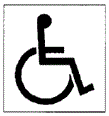For People with Disabilities, Which Circulation Paths Are Usable, Available, and Closest?
Exits should be marked by tactile signs that are properly located so they can be readily found by a person who is blind or has low vision from any direction of approach to the exit access.
Where not all circulation paths are usable by people with disabilities, the usable circulation paths should be identified by the tactile international symbol of accessibility:

The location of exit signage and directional signage for those with visual impairments is clearly and strictly specified by codes. The requirements include but are not limited to the type, size, spacing, and color of letters for visual characters and the type, size, location, character height, stroke width, and line spacing of tactile letters or braille characters. The specific code requirements are included in Annex C.
Special Note 6
It may be practical to physically take new employees who are blind or have low vision to and through the usable circulation paths and to all locations of directional signage to usable circulation paths. In addition, simple floor plans of the building indicating the location of and routes to usable circulation paths should be available in alternative formats such as single-line, high-contrast plans. These plans should be given to visitors who are blind or have low vision when they enter the building so they can find the exits in an emergency. Tactile and braille signs should be posted at the building entrances stating the availability of the floor plans and where to pick them up. Building security personnel, including those staffing the entrances, should be trained in all accessible building evacuation systems and be able to direct anyone to the nearest usable circulation path.
Special Note 7
The personal evacuation plan for a person who is blind or has low vision needs to be prepared and kept in the alternative format preferred by that person, including but not limited to braille, large type, or tactile characters.


User Comments/Questions
Add Comment/Question